Original title: Understanding Aethir: A Comprehensive Overview
Original article by Whynonah Messari
Compiler: Odaily Planet Daily Husband How
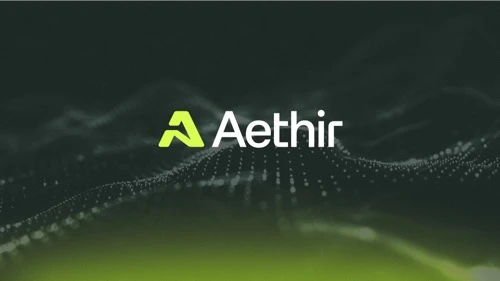
Key Insights
Aethir has partnered with companies such as EigenLayer, ai16z, Injective, Near, LayerZero, Beam, Filecoin, Metastreet, Manta Network, Sophon, Magic Eden, Animoca, and Return Entertainment.
Aethirs network includes approximately 400,000 GPUs (containers) distributed across 93 locations, providing more than 11 million tensor cores and serving approximately 191.61 million users.
In December, Aethir generated approximately $7.6 million in revenue, achieved annual recurring revenue (ARR) of approximately $90.68 million, and total computing time of approximately 266.19 million hours.
The core technology integrates virtual computing containers, quality verification checkers, and resource allocation indexers, supports 15-minute computing sessions, and provides real-time dynamic pricing.
As of December 31, 2024, the newly launched $100 million ecological fund has supported 20 AI-related projects (such as HeyAnon, ARC, TopHat, etc.), providing funding, subsidies and decentralized GPU resource access through four batches.
A total of approximately 642.83 million veATHs are staked, of which approximately 412.12 million are in the AI pool and approximately 230.71 million are in the game pool.
introduce
The AI market is valued at approximately $184 billion in 2024 and is expected to reach approximately $826 billion by 2030, while the gaming industry is expected to reach approximately $268 billion by 2025. Both industries are increasingly reliant on GPU-intensive applications, driving demand for high-performance computing. However, the high cost of GPUs (typically over $30,000 per unit) has created an “AI wealth gap” where large, well-funded companies dominate access to this infrastructure, making it difficult for smaller companies to compete—limiting innovation and limiting participation in both the AI and gaming markets.
Aethir solves these challenges through its decentralized cloud computing network, aggregating idle and underutilized GPUs into a global shared computing pool. Aethir provides a flexible service model that allows users to access enterprise-grade GPU resources on demand through:
(i) Infrastructure as a Service (IaaS), a pay-per-use model that provides virtualized GPU instances with services and tools for developing, testing, and deploying GPU-accelerated applications, provided through Aethir Atmosphere;
(ii) Bare metal solutions for users who want full control over their trained models on dedicated infrastructure, available through Aethir Earth. This decentralized approach reduces costs, increases accessibility, and promotes the democratization of advanced computing power.
background
Founded in 2021, Aethir is a decentralized enterprise-grade cloud computing network that provides scalable, globally distributed GPU resources for AI, gaming, and Web3 infrastructure. It provides AI chips (such as NVIDIA H100 and NVIDIA H200) to enterprises through a decentralized architecture, making performance computing more flexible and cost-effective.
The Aethir team includes Co-founder and Chief Strategy Officer Mark Rydon, who previously held positions at NOTA Platform, Flux Capital, and Bechtel Corporation; Co-founder and CEO Daniel Wang, who was previously CIO of YGG E 2, Head of International Publishing at Riot Games, and Head of Operations for Riot Games China; CTO Kyle Okamoto, who was previously CEO of Ericsson’s IoT and Edge Gravity business and Chief Network Officer at Verizon Media; and Chief Revenue Officer Paul Thind, who was previously General Manager of Disney VMK, COO of Outspark/Gamigo, and Co-founder and CEO of Triggerspot Inc, while also holding advisory and consulting positions at companies including Zynga, 20th Century Fox, Sanrio, and Trick Studios.
Since its inception, the Aethir team has raised more than $9.8 million in funding from investors such as Framework Ventures, Merit Circle, Hashkey, Animoca Brands, Sanctor Capital, and Infinity Ventures Crypto, and raised approximately $130 million through large-scale node sales. Aethir officially launched on the Ethereum mainnet on June 12, 2024.
technology
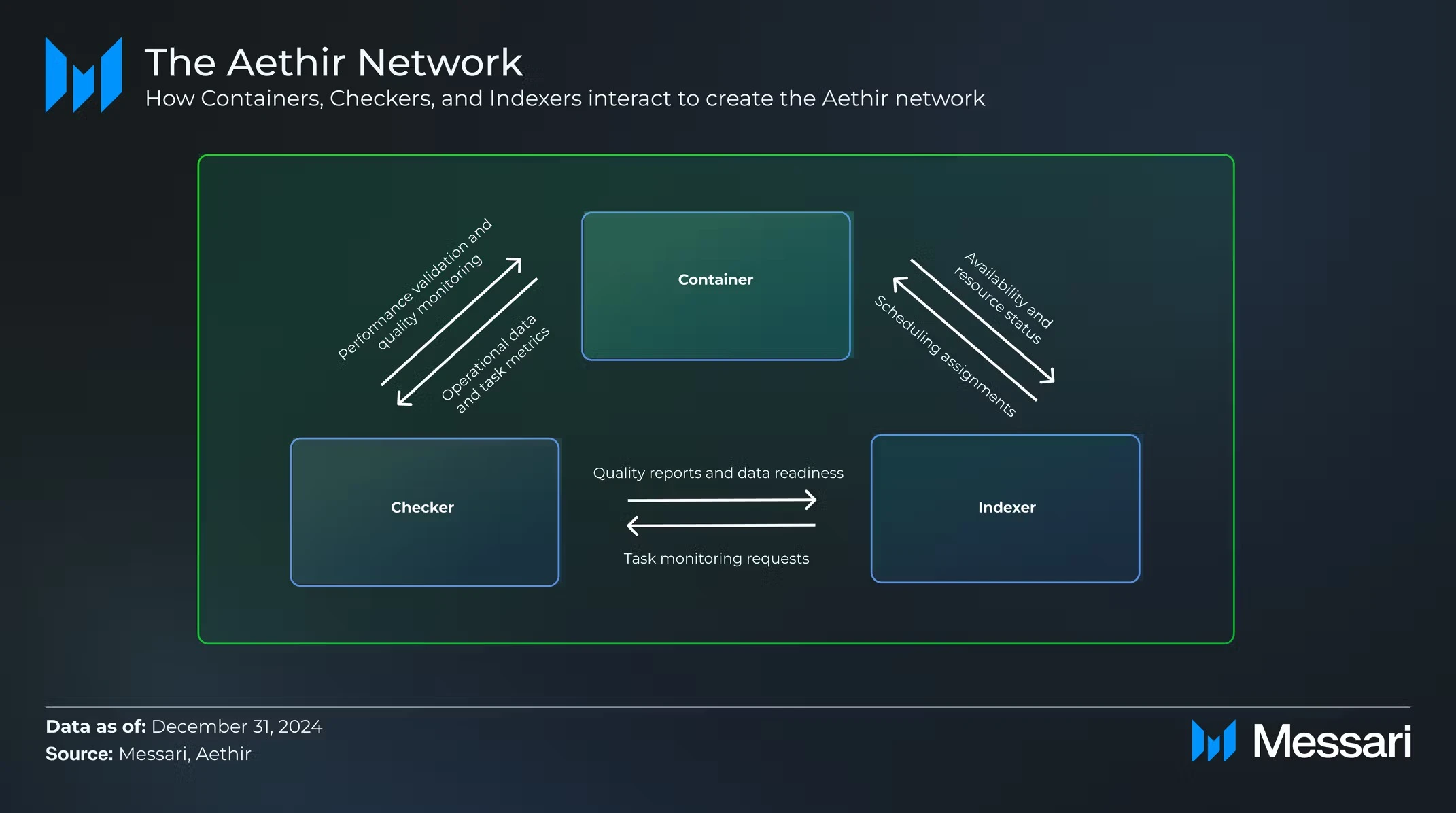
The Aethir Network consists of three core components:
Containers: Virtual or physical endpoints where applications are executed and rendered. Containers earn rewards by remaining in a state of readiness and providing computing services.
Checkers: Verifiers who ensure the integrity and performance of containers by performing checks at various stages such as registration, standby, and rendering. Checkers maintain the quality of service (QoS) through continuous performance verification and are incentivized through base rewards and bonus rewards.
Indexers: connect users with suitable containers, matching them based on multiple factors such as latency, quality of service, and cost.
These three components work together to facilitate computing sessions, which are the unit of operation for the Aethir network. Each session lasts 15 minutes, during which time the container executes user requests. Service fees are dynamically adjusted based on real-time demand, similar to a bidding system, with prices reflecting the availability and intensity of use of resources.
Below is a more detailed overview of these three components.
Containers
As a core part of the network, each container must meet the following requirements:
Meets specific processing and graphics benchmarks, supporting high-speed and low-latency interactions.
Always “ready”, with pre-installed applications and services, allowing instant activation upon request.
Verify compliance with network standards through performance checks.
Billing and usage of containers are directly tied to their activities:
Active Use: Containers receive service rewards when they perform tasks, compensating for their computational contributions during active use (such as proof of delivery and service fees).
Standby Mode: In standby mode, containers maintain high availability, are ready to be deployed at any time, and receive standby rewards (such as proof of capacity).
Containers must stake ATH tokens before contributing resources. Failure to meet performance standards (i.e. providing poor service or engaging in destructive behavior) will result in penalties (such as slashing staked tokens). Additionally, underperforming containers may face fee adjustments to reflect their reduced reliability.
Checkers
The checker maintains the integrity and performance of containers in the Aethir network by performing necessary quality checks, including:
Liveness Detection: Confirm the running status of the container through continuous heartbeat monitoring.
Rendering Quality Checks: Evaluate the performance of the container during active rendering to ensure compliance with network standards (i.e. proof of delivery).
Capacity Testing: Perform hardware assessments daily to verify service readiness (i.e. proof of capacity).
Successful verification can increase scheduling priority, while failure can lead to task reallocation or operator penalties.
There are two types of rewards available to inspectors:
Basic rewards: distributed daily based on task completion.
Bonus rewards: allocated every quarter to encourage outstanding performance.
These rewards are often referred to as checker node emissions and are issued in the form of ATH tokens as compensation. It is worth noting that checkers do not need to stake ATH tokens like edge nodes and IDC nodes. However, depending on the severity of the violation, checkers who fail to meet the quality benchmarks will face penalties, including temporary bans or permanent disqualification.
Additionally, through MetaStreet’s Yield Pass (live on the NodeFi platform), inspectors can now:
Unlock liquidity and gain immediate value by tokenizing and trading future node emissions;
Borrowing with nodes as collateral without selling the tokens you hold;
Maximize returns through staking and liquidity provision.
Participants who act as checkers are required to hold a Checker Node License, an ERC-721 NFT that allows operators to independently deploy nodes or delegate tasks using virtual or physical settings. Checker Node Licenses were first available through a strategic partner whitelist sale on March 18, 2024, followed by a public sale on March 20, 2024. The public sale has now ended and the licenses are expected to be traded on the secondary market.
To operate a Checker Node, operators need to install the Checker Node Client, a software application used to run and manage the node. For more information on previous Checker Node sales, click here .
Indexers
Indexers serve as a bridge between on-chain settlement and off-chain data processing, supporting enterprise workloads. They connect users to the most appropriate container, ensuring the lowest latency and optimized experience of second turn on services. Scheduling is based on several factors:
Container status (i.e. standby status).
Whether the container has an application pre-installed.
Hardware and network compatibility.
Low latency to the users location.
The cost of the service shall not exceed the requested budget.
Priority is given to lowest fees, best user experience, or highest review scores. In addition, Indexers are randomly selected to promote decentralization, reduce fraud risks, and avoid delays caused by protocol complexity.
Compute Providers
While compute providers are not a clearly defined core component, they are critical to the ecosystem—they provide physical GPU hardware, which is then used to create containers that perform computing tasks within the network. Users can also contribute resources by purchasing an Aethir Edge device, an edge computing hardware device equipped with a GPU that is directly connected to the network.
To participate, computing providers must stake ATH tokens, with the amount of staked depending on multiple factors (i.e., the global average stake factor, GPU specifications (K value), and the number of tokens emitted in the previous month). Staking is mandatory throughout the operation, configuration changes require re-staking, and unstaking requires a 180-day unlocking period.
Computation providers receive balance rewards through the following mechanisms:
Proof of Capacity (PoC): Rewards are distributed daily based on GPU availability, uptime, and K value of the container.
Proof of Delivery (PoD): Get rewarded after completing a computational task based on task complexity and rendering time.
Edge Device Rewards: Calculated according to the emission schedule and are subject to a 5% network fee.
On the buyer side, service fees are settled in fiat currency and paid in ATH tokens, with the platform deducting a 20% platform fee. The Aethir platform sets a benchmark unified price for containers, based on the region and specifications of the container, and provides different pricing structures for Reserve and On-Demand models.
Additionally, penalty mechanisms (including slashing) ensure accountability through reward forfeiture, and in severe cases, lead to loss of staked collateral and removal from the network for downtime or performance failures. More details on the above can be found here.
General Overview
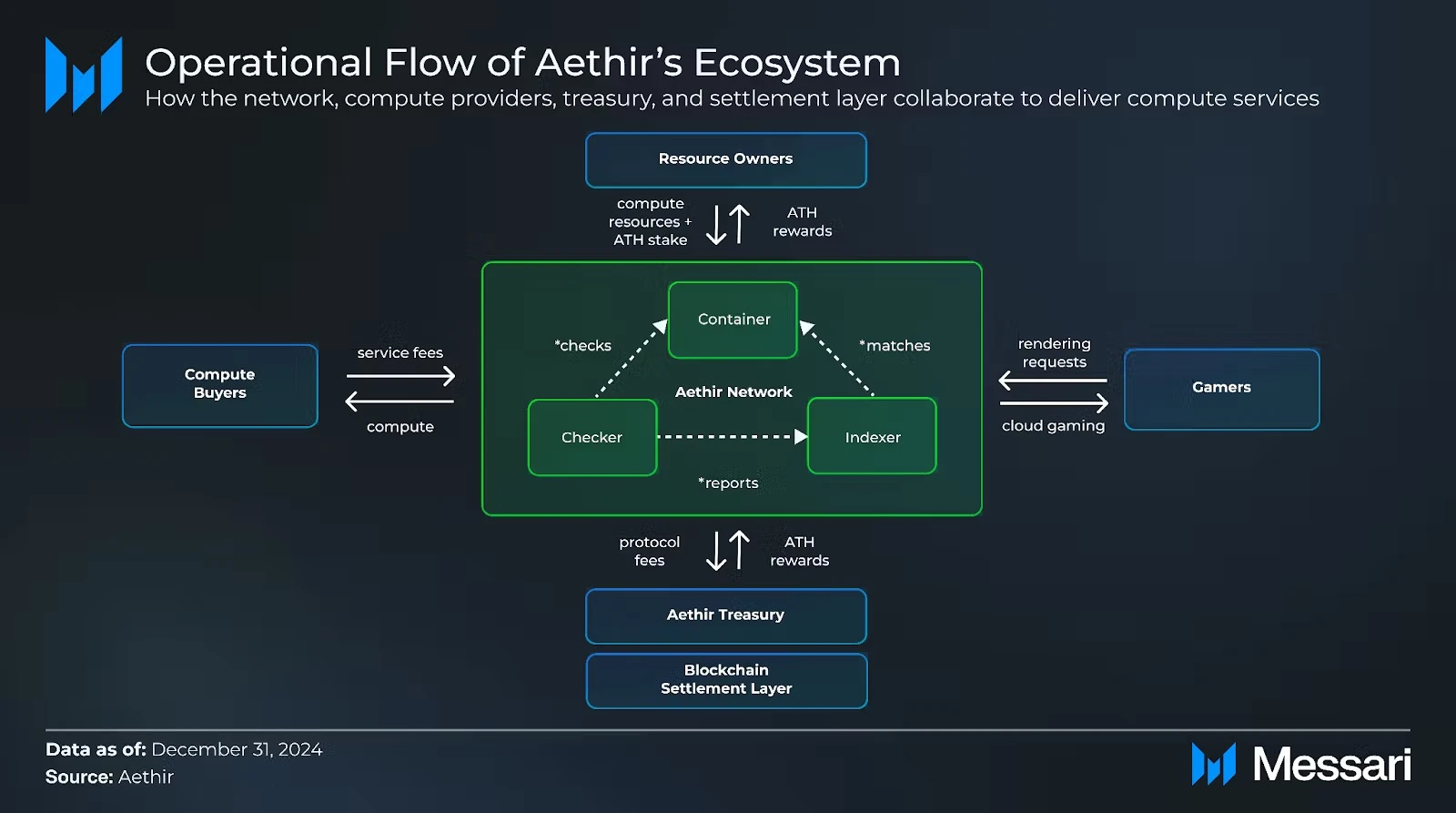
While the Aethir Network and compute providers form the backbone of the infrastructure, they operate within a broader ecosystem that includes three other key components: (i) compute buyers and players, who use the network’s computational power; (ii) the Treasury, which manages network fees and distributes ATH tokens for protocol development and growth; and (iii) the Settlement Layer, which records transactions and distributes ATH rewards. Here’s an example of how they work together:
A company submits a request for computing resources to Aethir, specifying GPU requirements, latency expectations, budget, and duration of the cloud gaming service.
The indexer matches requests to appropriate containers based on performance, location, and service cost criteria.
The assigned container performs real-time rendering tasks, streaming game graphics to player devices with minimal latency.
Inspectors monitor container performance, verifying specifications, rendering quality, and ensuring compliance with Aethirs standards.
Players enjoy a seamless gaming experience through the containers computing resources.
Computing providers (resource owners) provide GPUs, contribute computing power to the Aethir network, and receive ATH rewards.
Companies pay for their services and the Aethir Treasury processes these fees, distributing ATH rewards to resource owners and paying protocol fees.
The blockchain settlement layer records all transactions, ensuring transparency and accountability, while also recording Proof of Capacity and Proof of Delivery data.
Through its technology and systems, Aethir offers two distinct products designed to meet the needs of AI applications and games:
Aethir Earth: Bare metal local GPU resources for compute-intensive tasks such as AI model training and machine learning, providing high performance, scalability without virtualization overhead, reliability, and optimized performance.
Aethir Atmosphere: A decentralized rendering container for real-time, high-quality cloud gaming experiences, allowing for low-latency, scalable, and seamless gameplay across devices.
ATH Token
Token Function
According to the project’s documentation, ATH runs on Ethereum as an ERC-20 token and on Arbitrum as an ArbERC-20 token. It performs several key functions in the Aethir network, including:
Pay for services on the Aethir network (e.g., GPU computing required for AI applications, cloud gaming, and virtualized computing tasks).
Staking supports network operations and earns staking rewards.
Compute providers and containers earn rewards through Proof of Capacity (PoC) and Proof of Delivery (PoD) mechanisms, which are distributed through Ethereum.
Inspectors receive base and bonus rewards based on task performance, while Aethir Edge devices receive emissions-based rewards. All Inspector and Edge rewards are distributed via Arbitrum.
Token holders can stake ATH tokens in AI or gaming pools to earn regular rewards, all of which are distributed via Ethereum, and gaming pools also provide additional veCARV tokens through a partnership with the CARV protocol.
Once the DAO is launched, participate in governance decisions including platform updates, platform parameters, staking requirements, and other network updates.
Token Economics
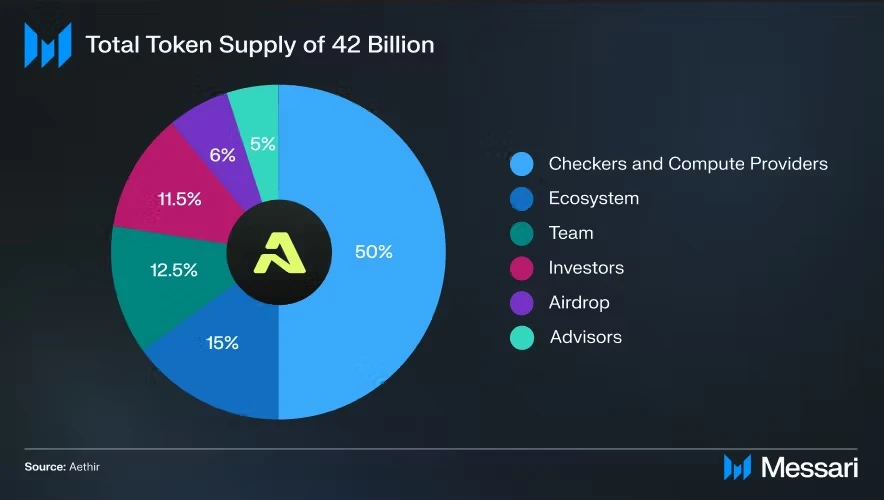
The above chart shows the distribution of ATH tokens (as of December 31, 2024, the total valuation of ATH is approximately $2.94 billion, and the ATH price is approximately $0.07):
Checkers and Calculation Providers: 50.00% (2.100 billion ATH, approximately $1.47 billion)
Team: 12.50% (525 million ATH, about $367.5 million)
Ecosystem: 15.00% (630 million ATH, approximately $441 million)
Investors: 11.50% (483 million ATH, about $338.1 million)
Airdrop: 6.00% (252 million ATH, approximately $176.4 million): The airdrop will be carried out in three seasons to reward long-term ecosystem participants, with 1.50% each allocated in the first and second seasons and 3.00% allocated in the third season.
Advisors: 5.00% (210 million ATH, approximately $147 million)
It is worth noting that Aethirs computational reward emission uses a decay function to balance early-stage launch with long-term sustainability, ensuring that later participants can also receive incentives. Detailed information about the specific emission will be released later.
Token Vesting
The following are the vesting arrangements for the parties:
Checkers and Compute Providers: Checkers follow a four-year linear vesting plan tied to performance, while Edge and Enterprise Compute Providers follow a specific award vesting schedule.
Team: 18 months cliff, followed by 36 months of linear vesting.
Ecosystem: 50.00% released at the Token Generation Event, the remainder vests linearly over 24 months. The DAO Treasury follows a 48-month linear vesting schedule.
Investors: 12 month cliff followed by 24 month linear vesting.
Airdrops: 25.00% at the Token Generation Event; 25.00% after 8 months; the remaining 50.00% after another 8 months.
Governance
According to Aethir’s latest roadmap, Aethir’s governance framework is scheduled to be implemented in the fourth quarter of 2024 in four phases:
Development phase: Building core elements (e.g., smart contracts, voting mechanisms, and staking functionality).
Community Education and Engagement: Conduct workshops and training sessions to prepare stakeholders for engagement.
Beta testing: Rolling out a trial version of the governance system to selected users to test functionality and provide feedback.
Official release: Deployment of the final governance system after adjustments.
Specifically, governance will consist of the following two parts: 1. Committee: managing the day-to-day operations of the ecosystem; 2. Foundation Board: overseeing major initiatives (for example, decisions related to the treasury and important governance decisions).
Two years after the launch of governance, ATH token holders holding more than 5.00% of the circulating token supply will be able to propose changes directly, bypassing the committees support. The committee will be composed of the following representatives:
Compute Providers: Two representatives (Edge and Enterprise) are elected based on their contribution to the ecosystem.
Checkers: Elected based on their contribution to the ecosystem.
ATH Token Holders: All ATH token holders are eligible to vote, and staked ATH (veATH) will confer enhanced governance privileges and increase voting power by 1.5x.
Indexer Representative: Elected by the governance vote of the staked ATH token holders, the indexer will serve for a three-year term, unless removed due to governance voting, insolvency, non-compliance or operational failure, in which case a by-election will be held. Indexers cannot serve as computing providers or checkers at the same time, and are responsible for managing computing allocation by monitoring resource usage and service level agreements, and reporting resource needs to the committee and the foundation board.
Foundation Representative
In addition to the committee, there is an additional security layer, namely the multi-signature group (Sentinel) elected by the community, which is regularly updated through community governance voting. Their main responsibilities include: 1. Veto changes to the constitution or proposals, especially those that are considered harmful; 2. Publish the reasons for any veto to ensure transparency.
Any veto requires committee approval. However, 24 months after the governance mechanism is activated, an override mechanism will be enabled, and a community vote of more than 75.00% will be able to overturn a committee veto. Each proposal will go through the following stages:
Temperature Check: A preliminary phase to gauge community interest in a proposal.
Debate: Formal discussion to refine proposals and resolve issues.
Implementation preparation: Prepare necessary on-chain changes based on the content of the proposal.
Decision-making: The final on-chain vote determines whether to implement the proposal.
More details on quorums, proposal types, proposal categories, and amendments can be found here .
Aethir Ecosystem Status
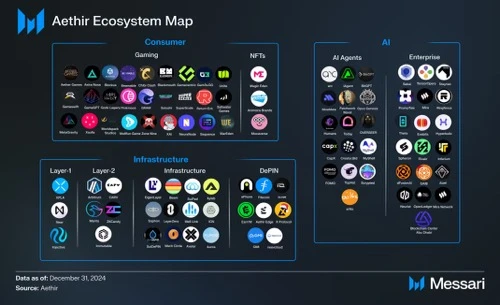
Key Projects
Infrastructure:
EigenLayer: EigenLayer is a blockchain infrastructure that supports Restacking and works with Aethir to enable ATH holders to stake and delegate on EigenLayer, thereby simplifying the onboarding of GPU providers and increasing staking rewards.
Near: NEAR Protocol is a scalable, developer-friendly public blockchain that is partnering with Aethir as part of the Delphi Labs AI accelerator program, with Aethir providing GPU resources to support participating projects.
Injective: Injective is a Layer 1 optimized for DeFi applications, working with Aethir to create the first tokenized market for GPU computing resources.
LayerZero: A full-chain interoperability protocol that works with Aethir to provide multi-chain capabilities by integrating their networks.
Axelar: A cross-chain communication network that enables secure transmission of messages and tokens. Aethir simplifies the ATH token bridge between ETH and Arbitrum by integrating Axelar’s Interchain Token Service (ITS) and the Squid platform.
Auros: A market making and algorithmic trading company that will provide liquidity for the ATH token.
Filecoin, a decentralized storage provider, has partnered with Aethir to integrate GPU rental services for its storage providers, enable on-demand data sealing, and create a complete decentralized computing and storage solution.
Manta Network: A modular Ethereum Layer 2 that integrates decentralized GPU resources in collaboration with Aethir.
AI:
TensorOpera: An AI platform that integrates Aethir’s distributed GPUs into its Nexus AI platform, offering competitive pricing for model deployment, fine-tuning, and training.
Ai16z: An AI agent framework that works with Aethir to provide elizaOS developers with a streamlined path for GPU grant applications.
Ecosystem Fund Projects:
Batch 1: Includes TopHat (a no-code AI agent launchpad) and Capx AI (a platform that allows users to build, own, and trade AI agents), among others.
Batch 2: includes ARC (AI Arena, an AI agent launch platform) and BitGPT (a front-end interface for on-chain transactions and education), etc.
Batch 3: Includes iAgent (an AI training platform for training AI agents for players) and MyShell (an AI consumption layer that allows developers to easily build, share and own AI applications), etc.
Batch 4: Includes HeyAnon (a DeFAI tool) and dFusion AI (a decentralized platform for collecting high-quality data), etc.
Mira: An AI verification platform that provides trustless verification of AI outputs, has partnered with Aethir to combine its trustless verification technology with Aethir’s decentralized GPU network to reduce AI error rates from 30% to 5%.
OpenLedger: A platform that provides data blockchain for AI, partnered with Aethir to use its decentralized GPU network.
game:
Magic Eden: An NFT trading platform that leverages Aethir’s GPU power to support gaming partners while serving as the preferred NFT platform for Aethir’s gaming customers.
Return Entertainment: A cloud-based gaming platform focused on immersive experiences, using Aethir’s GPU network to power its cloud gaming platform, which is located on Samsung’s Cloud TV gaming hub.
Immutable: A Web3 Layer 2 platform focused on NFTs and blockchain games, secured by Ethereum and using Aethir to provide GPU cloud infrastructure to help game developers and publishers build and publish games in the Immutable ecosystem.
Sequence: A Web3 game development platform that leverages Aethir to provide scalable GPU cloud infrastructure, supports features such as NFTs and in-game marketplaces, and provides a seamless Web3 gaming experience.
Sophon: A zkSync superchain focused on AI, gaming, and entertainment, integrating Aethir’s decentralized GPU cloud. Both networks enhance decentralization through common node exchange.
Xsolla, a global video game commerce company, has partnered with Aethir to provide decentralized GPU infrastructure support for its pay-as-you-go (PAYG) cloud gaming platform.
SuperScale: A gaming growth engine and analytics platform, in partnership with Aethir, supports mobile gaming through case studies of its user acquisition and downstream metrics.
MetaGravity: A gaming infrastructure company that leverages Aethir’s decentralized GPU cloud to power its HyperScale Engine.
Strategic Initiatives
$100 million ecosystem fund
In October 2024, Aethir launched a $100 million ecosystem fund to support innovation in the AI and gaming sectors in phases. The first phase launched the Aethir Catalyst program, providing $10 million in XAI grants and $10 million in XPLA grants. The fund provides the following support: (i) financial grants ranging from $5,000 to $200,000 (paid in ATH tokens) to help AI and gaming projects start and sustain operations; (ii) discounts of up to 35% on Aethirs GPU computing services for contracts of six months or more; and (iii) access to Aethirs hardware ecosystem (such as Aethir Edge).
Applications for grants and subsidies are conditional on using the Aethir platform or collaborating through token distribution. The Aethir Grant Committee will evaluate applications based on computing needs, user appeal, revenue metrics, and project innovation. Applicants can participate here.
Since the launch of the fund, 20 projects with AI agents as the core have passed four batches of review. For details, please see the key projects section.
Tactical Computing Initiative
Past grants include Tactical Compute (TACOM), a $40 million AI computing initiative with the Beam Foundation and MetaStreet that uses Aethir’s GPU network to address computing resource shortages and supports AI-crypto projects through hardware financing, yield arbitrage, and network bootstrapping.
other
Additionally, Aethir has partnered with Blockchain Center Abu Dhabi, a global innovation hub, to expand its reach and support in the Middle East and North Africa (MENA) region.
Network Metrics
On the supply side, the Aethir network consists of approximately 400,000 GPUs (containers) distributed across 93 locations, providing computing power of over 11 million tensor cores as of December 31, 2024. The monthly computing power supported by the current infrastructure can serve approximately 193.7 million people.
On the demand side, monthly revenue in December 2024 reached approximately $7.6 million, with annualized recurring revenue (ARR) of approximately $90.68 million, an increase of approximately 46.82% from $5.18 million in November, and total computing hours reached approximately 266.19 million hours. A comparison of these metrics with other DePIN projects can be found in the Messari 2024 DePIN Status Report.
As for on-chain metrics, as of the end of December, the AI pool’s staked veATH reached ~412.12 million, while the gaming pool’s staked veATH was ~230.71 million, showing a ~2.64% month-over-month increase and ~0.31% decrease, respectively, bringing the total staked in all pools to over $1.5 billion. More metrics (such as average annualized yield, total trading volume, etc.) can be viewed in this dashboard.
Roadmap
On August 22, 2024, Aethir released a comprehensive six-month roadmap to supplement its existing documentation. Here is what it looks like after the merger:
Q3/Q4 2024:
Aethir Cloud Portal: Simplifies the onboarding process for enterprise customers, provides seamless access to Aethir’s GPU infrastructure, and simplifies ATH token payment services.
Sophon Migration: Expansion to the Sophon blockchain to increase liquidity of ATH tokens and expand staking opportunities.
Aethir Governance Launch: Introducing a decentralized governance model.
Ecosystem Fund and Aethir Incubator Launch: (i) Launch a fund to support developers and builders within the Aethir ecosystem; (ii) Launch an incubator program to support early-stage projects in the fields of AI, gaming, and computing infrastructure.
2025:
AI Model as a Service (PaaS): Launch a platform as a service model to provide developers with a pre-configured AI/ML technology stack.
Game Showcase Portal: A portal showcasing game projects built on Aethir infrastructure.
Expanding Aethir Edge capabilities: Introducing AI inference capabilities and cloud telephony use cases, enhancing AI-powered agents.
Aethir Air: Adds native SDKs for Windows and iOS to enhance developer tools.
Aethir Earth: Launches an open API for managing bare metal machines.
Summarize
Aethir provides distributed cloud infrastructure for AI and gaming by aggregating idle and underutilized GPUs into a global shared pool of computing resources. It delivers enterprise-grade performance at a lower cost through two main products: (i) Aethir Earth, which provides local bare metal GPU resources to support compute-intensive workloads; and (ii) Aethir Atmosphere, which supports real-time cloud gaming through decentralized rendering containers. The platform integrates containers, inspectors, and indexers to ensure the quality and efficiency of resource allocation for computing resource providers.
Aethir is empowering developers and enterprises through its $100 million ecosystem fund, supported by strategic partnerships. Specifically, Aethir has helped 20 AI agent-focused projects through four batches and provided a simplified path to access GPU funding for developers of the ai16z Eliza agent framework.
As of December 31, 2024, Aethirs network consisted of approximately 400,000 GPUs (containers) distributed across 93 global locations, with monthly revenue of approximately $7.6 million in December 2024, an increase of approximately 46.82% from $5.18 million in November.
Looking ahead, Aethir plans to expand governance mechanisms, launch an ecosystem incubator, and enhance infrastructure with new features, including better support for developers and enterprises that rely on GPU-powered solutions.










